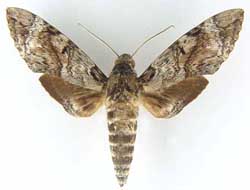Smerinthini thumbnails
Dilophonotini:
Callionima, Erinnyis, Hemeroplanes, Isognathus, Madoryx, Phryxus, Pseudosphinx
Thumbnails: Argentina

Isognathus leachii, Depto Cainguas, Aristobulo del Valle, A Cuna Piru, Misiones, Argentina,
March 27, 2008, courtesy of Leonardo Aguado.
This tentative checklist will become more accurate as images and information are sent to me. If you would like
to assist in the development of this worldwide Sphingidae data/image
base, please send info and images to Bill Oehlke.
I have arranged the images in accordance with my perception of wing characters: predominant markings, shape, colour,
size.
Females often have a wing shape or pattern that differs from the males. I hope some day to also have a thumbnail checklist for the females.
This page is inspired by and dedicated to Leonardo Aguado who has provided the Isognathus leachii image at the top of the page.
Callionima
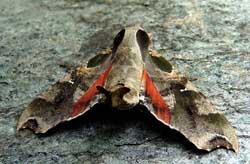
C. g. grisescens EB/CM/NV
May be greenish grey over light grey or orangey brown over beige
light grey apical arc broadens in its completion just below hollowed out portion of
outer margin; enclosing a darker area.
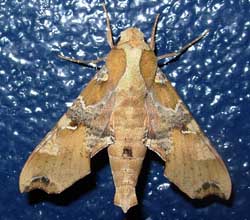
|

Callionima p. parce
Apex pointed
White apical line slightly concave,
outwardly traced in black,
expanding at M1 into pale patch, curving back up outer edge of line towards apex.
Pale, preapical, coastal patch less pronounced,
darker in lower half,
internal "webbing" indistinct
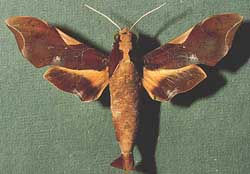
Callionima nomius
White apical line completes full, shallow arc
below midpoint of outer margin.
Lacks pale, preapical, coastal patch
Pale triangular patch above cell elongated on costa
Rest of forewing primarily dark brown
|
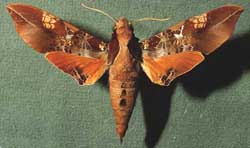
Callionima inuus
White apical line very oblique, pointing
toward midpoint of inner margin
Pale, preapical, coastal patch well developed,
internal "webbing" distinct
|
|
Erinnyis
Only alope has yellow hindwings;
Only alope, ello, lassauxii and impunctata have barred abdomens;
Domingonis might be just a dark form of obscura.
When hindwings and abdomens are visible, they are a great help with determinations.
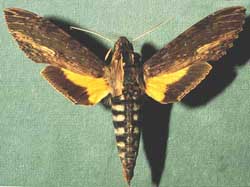
Erinnyis alope
Fw: dark brown; paler region along i.m. to pml, then oblique to mp of o.m.
Darker near anal angle.
Hw: yellow, wide dark brown border.
Similar to Isognathus species, but has double thoracic crest (single in Isognathus);
very dark brown (sometimes almost black) upperside to head, thorax & forewings.
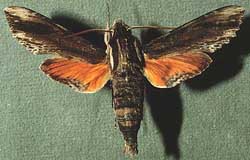
Erinnyis domingonis
CATE 2009 does not recognize domingonis as a valid species,
equating it with obscura. On FGS it is still regarded as distinct.
Black, somewhat oblique, center line is masked by overall dark scaling.
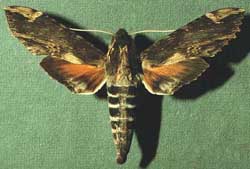
Erinnyis lassauxii
|
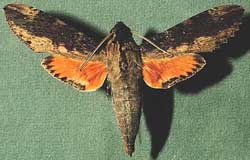
Erinnyis crameri
Fw: dark brown; paler region along entire i.m., widening to above mp of o.m.
Pale near anal angle.
Lighter apical, costal patch.
Hw: orange, narrow dentate brown border.
Abdomen without dark bars.
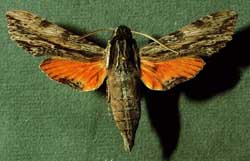
Erinnyis o. obscura
Fw: pale gray with black markings;
prominent narrow black center line, from base to about 3/4ths wing
length.
M & F: hw orange, narrow black border.
Female: almost uniform grey forewings with black markings on basal half and near
center of costa like E. ello; some females nearly all black.
Erinnyis lassauxii to the left should be immediately
recognizable by subtriangular pale patch, peaking slightly before midpoint (body side) of the inner margin.
There is also a pale apical costal area with a noticably straight inner edge.
Otherwise rest of wing is predominently dark.
The dull orange area of the hindwing is greatly reduced.
|

Erinnyis oenotrus
Fw: dark brown; slightly paler region along i.m. from pm line to outer margin
Dark markings near anal angle.
Lighter apical, costal patch with darker markings.
Hw: dull orange, brown border of intermediate width.
Abdomen without dark bars.
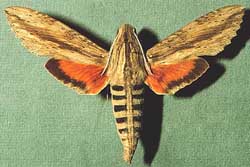
Erinnyis ello ello
Fw: lighter brown and grey compared to other species with
diffuse dark band running from wing base to wing tip.
Abdomen: distinct gray and black bands.
M & F hw: orange, wide black border.
Female fw: pale gray without dark band.

Er. impunctata EB
similar to Erinnyis lassauxii f. merianae, but impunctata is smaller and lacks black dots on the underside of the abdomen
|
|
++++++++
Isognathus
Moths in the first row can be difficult to determine from photos only.
But look for the following:
excelsior: whitest, especially in upper 2/3 of pm area; thinner streaks and bars.
occidentalis: darkest, thickest streaks and bars.
menechus: bluish-grey cast; prominent white areas on veins in pm area.
Moths in second row are a bit easier with russet ground colouor:
scyron: no basal dash.
leachii: heaviest dark basal dash; generally heavier dark bars and dashes.
swainsonii: thinner basal dash; biggest difference between leachii and swainsonii expressed in red below.
Caricae in third row is quite distinct. I do not think rimosa papayae is present, but it is quite white.
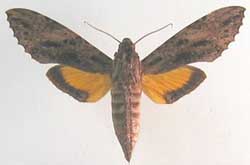
Isognathus leachii
Similar to Isognathus swainsonii.
Black, basal strak 2.5 mm broad.
Crossvein m2-m3 pale, distinctly separating small dark brown cell patch from
elliptical spot distal to m2-m3.
Black streak between M3, CuA1 heavy, connected with curved patch below CuA2.
Greyish-white scaling sparse, no distinct interrupted grey vein-streaks posteriorly.
Hw: Inner edge of dark brown marginal band distinctly dentate, not constant in width.
Depto Cainguas, Aristobulo del Valle, A Cuna Piru, Misiones,
March 27, 2008
|
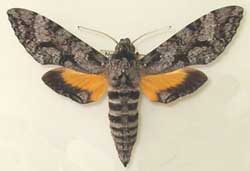
Isognathus menechus
Body, fws have bluish-grey cast.
Forewing: double antemedian, double postmedian lines, distinct at costa.
Pm pair interrupted at M3, then reappear posteriorly, quite concave,
forming semicircle opening towards anal angle. Elongate black patch between M3 and CuA1 merges basally with postmedian lines.
Distal white vein-streaks generally conspicuous.
|
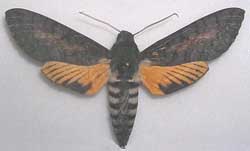
Isognathus c. caricae
Fw: two elongated orangey-brown patches connected below cell mark, smaller basal patch along i. m.;
otherwise dark grey.
Only Isognathus species with hw dark marginal band replaced by series of black
streaks along veins.
|
|
++++++++
Hemeroplanes

Hem. longistriga EB
|
Hemeroplanes longistriga to left: has an elongate white striga on forewing
Hemroplanes triptolemus to right: abdominal yellow bands extend across entire width of segments.
Fw: little or no greenish-yellow scaling. Silver mark: 4-5 mm long, basally forked, not nearly as long as in longistriga.
|

H. triptolemus
|
|
++++++++
Madoryx

Madoryx b. bubastus
Upperside of body and wings olive-brown.
Forewing apex is truncate.
Upper silver discal spot: small, rounded or ovate.
Lower silver spot irregularly triangular,
with upper inner edge directed towards
costa.
Very acute angle formed by two pales lines near end of Rs4,
outer line ends at tip of CuA1, inner line ends near i.m. midpoint, enclosing
darker area.
Broadly preapical, pale line, emanating from costa, meets pm line at an internal angle slightly less than ninety degrees.
Lower two-thirds of forewing outer margin slightly scalloped
|
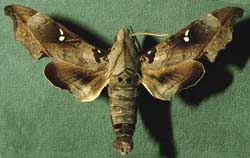
Madoryx o. oiclus
Upperside of body and wings silver-grey.
Forewing apex is truncate.
Forewing upperside with a narrow olive-green basal band; the silver discal spots are almost equal in size,
in most specimens the upper one is transverse and the lower one more-or-less rounded.
Very acute angle formed by two pales lines near end of Rs4,
outer line ends at tip of CuA1, inner line ends near i.m. midpoint, enclosing
an almost concolorous area.
Broadly preapical, pale line, emanating from costa, meets pm line at an internal angle slightly greater than ninety degrees.
Lower two-thirds of forewing outer margin heavily scalloped
|
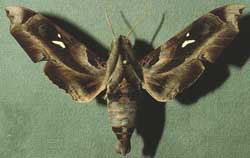
M. p. plutonius
Note the silver, triangular discal patch, capped with a dot in the median area.
Forewing tips are lighter in colour in plutonius and are also broader, not truncated, and are less hooked than in other
Madoryx species. The lower portion of the forewing outer margin is quite straight.
|
|
++++++++
+++++++
Use your browser "Back" button to return to the previous page.
This page is brought to you by
Bill Oehlke and the
WLSS. Pages are on space rented from Bizland. If you would like
to become a "Patron of the Sphingidae Site", contact Bill.
Please send sightings/images to Bill. I will do my best to respond to
requests for identification help.
Visit Argentina Thumbnail Checklists:
Sphingini: Manduca
Sphingini: Agrius, Amphimoea, Cocytius, Euryglottis, Lintneria, Sphinx
Smerinthini: Adhemarius, Orecta and Protambulyx
Dilophonotini: Aleuron, Enyo, Pachylia, Pachylioides and Unzela
Dilophonotini: Aellopos, Eupyrrhoglossum, Nyceryx and Perigonia
Dilophonotini: Callionima, Erinnyis, Hemeroplanes, Isognathus, Madoryx, Pachylia, Phryxus
and Pseudosphinx
Philampelini: Eumorpha
Macroglossini: Hyles and Xylophanes
 | 
Show appreciation for this site by clicking on flashing butterfly to the left.
The link will take you to a page with links to many insect sites. |
























